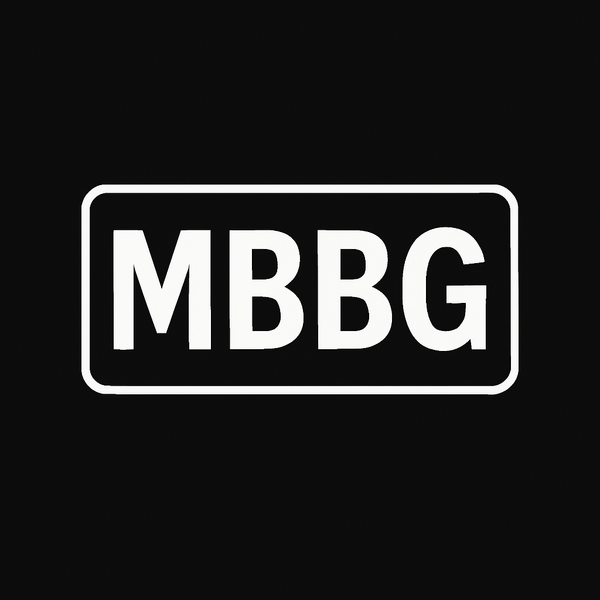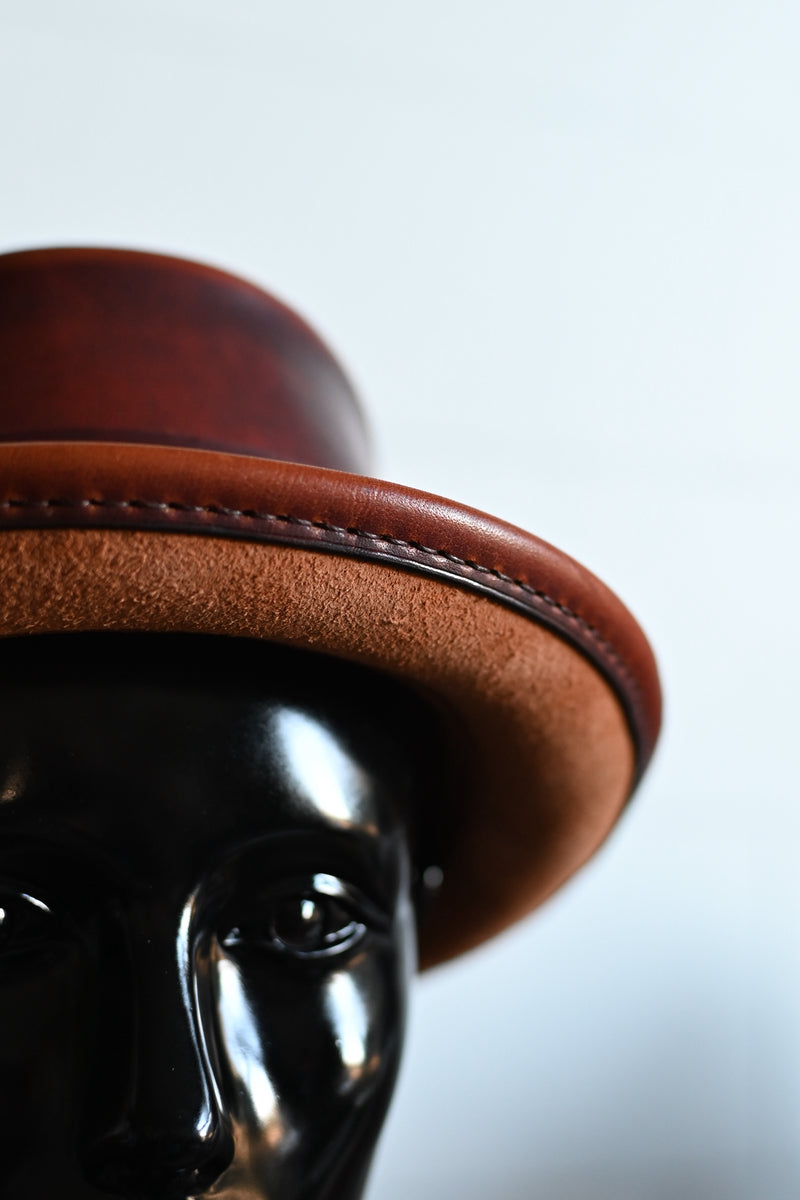
The Leather Center
"Welcome to our resource hub, where you'll find helpful tips and insights to deepen your understanding of leather."
Leather has been a cornerstone of human craftsmanship for as long as history can recall, making it one of the earliest crafts ever practiced. The need to transform animal hides into durable materials for clothing, shelters, footwear, and countless other essential items led to the discovery of tanning—a process that prevents decay and preserves the skin.
But how much do we truly understand about leather in today’s modern age? At our Leather Center, we’re dedicated to helping you explore the world of leather, uncovering its rich history, diverse applications, and unique qualities.
What Is Leather?
Leather’s longevity & versatility stem from its primary structural component:
Collagen fibers are the foundation of leather's strength, flexibility, and durability. Found in the dermis layer of animal hides, collagen is a structural protein that forms a dense, intertwined network of fibers. This natural composition is what makes leather such a versatile and long-lasting material.
During the tanning process, these fibers are stabilized, preserving the hide’s strength and making it resistant to decomposition. This unique composition has made leather a proven material for centuries, valued for its reliability and adaptability across diverse applications, from footwear and clothing to automotive interiors and industrial tools.
However, leather can become damaged through everyday use, including exposure to moisture, UV light, abrasion, and neglect, which can compromise its structure and appearance over time without proper care.
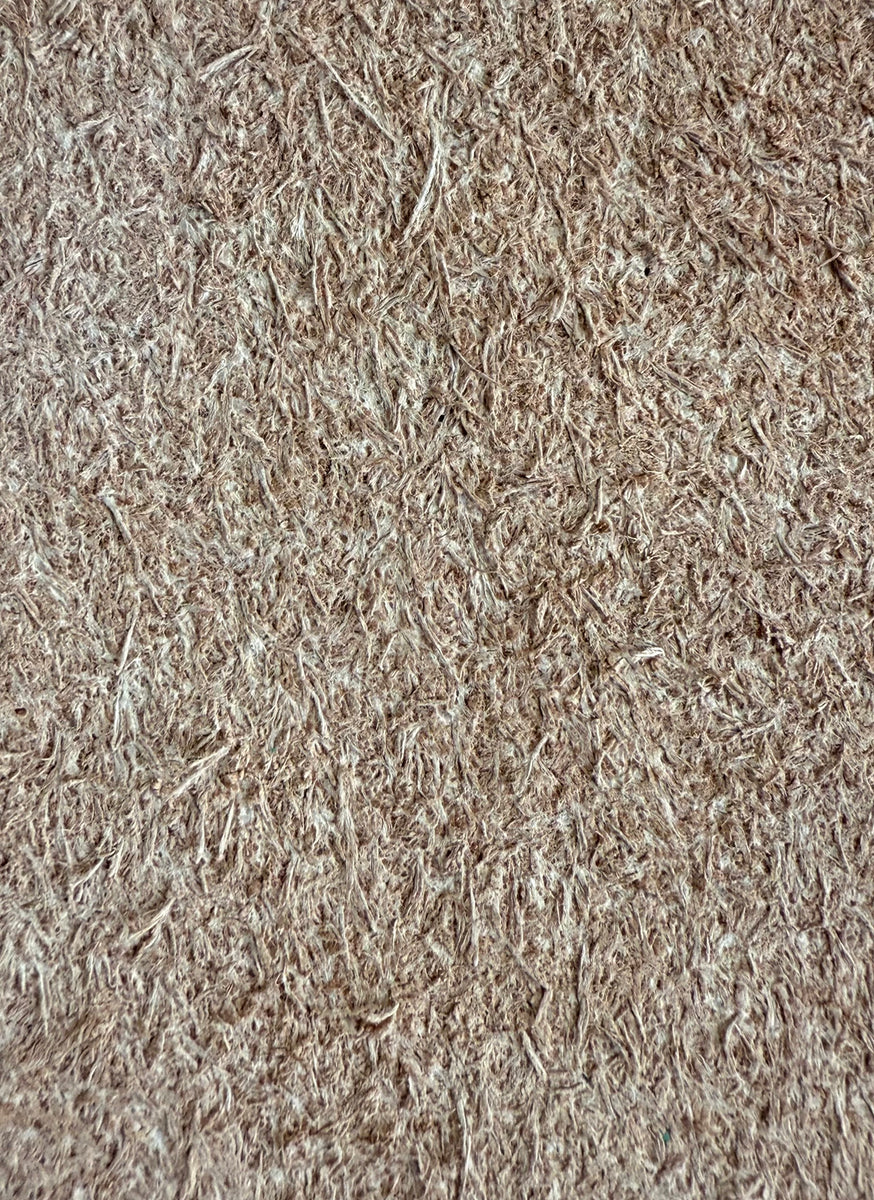
The Role of Collagen in Leather
Why Collagen Makes Leather Exceptional:
Strength and Durability: Collagen fibers are what make leather tough and resistant to wear and tear. They enable the material to endure heavy use, making it suitable for applications ranging from fashion to furniture to automotive interiors.
Elasticity and Flexibility: The unique arrangement of collagen fibers contributes to leather's ability to bend and stretch without cracking. This elasticity enhances comfort, especially in items like gloves, seats, and clothing.
Breathability: Collagen-based leather is porous, allowing it to regulate moisture effectively. This breathability prevents items from feeling overly hot or sticky, making leather a preferred choice for upholstery and garments.
Patina Development: As collagen ages, it interacts with oils, moisture, and sunlight, developing a rich patina that enhances the leather's character. This aging process makes leather unique and adds to its timeless appeal.
Repairability: The inherent properties of collagen in leather make it highly repairable. When properly treated with leather care products, the material can recover its flexibility and maintain its structural integrity for decades.
Tanning Process and Collagen Stability
Tanning transforms raw hides into leather by stabilizing collagen fibers, preventing decomposition and enhancing their natural properties. Different tanning methods (vegetable, chrome, or chrome-free) interact with collagen in unique ways, giving rise to a variety of leather types suitable for specific purposes.
Sustainability and Longevity
Since collagen is a natural protein, leather products are biodegradable when untreated with synthetic finishes. By extending the life of animal hides through the tanning process, leather utilizes a byproduct of the meat industry, reducing waste and promoting sustainability.
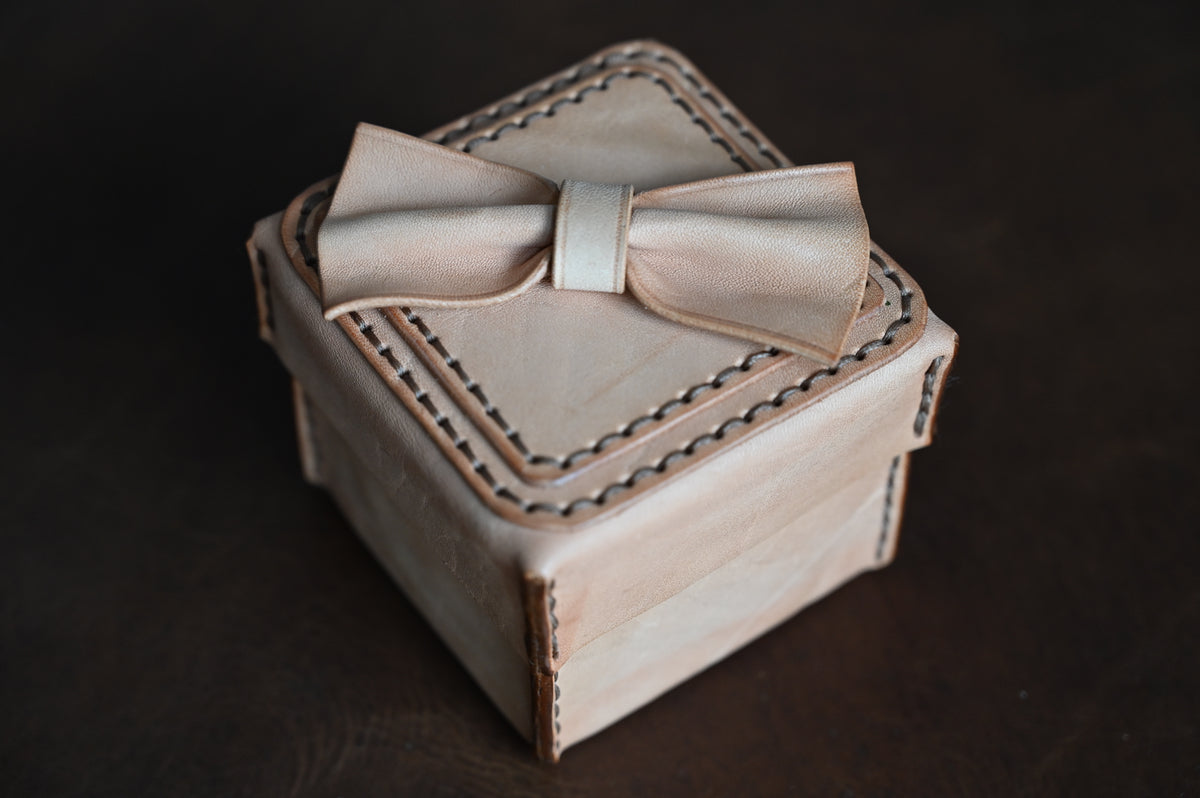
Leather Tanning
Leather tanning began in ancient times when early humans discovered ways to preserve animal hides, preventing them from rotting. Initially, they used natural substances like tree bark, leaves, and even animal fats to treat the hides. These primitive methods evolved as people observed that certain materials, such as tannin-rich plants, helped create more durable and flexible leather. This foundational knowledge laid the groundwork for modern tanning techniques, marking the start of one of humanity’s oldest and most enduring crafts.
Nature of Leather: Absorbency and Care
Leather has been stabilized against decay through various tanning methods for centuries. One fascinating aspect to consider when exploring how leather is made is its absorbent properties. As leather is a form of skin, the tanning process determines its ability to absorb or release moisture. Much like human skin, leather responds to its environment—absorbing moisture or releasing it, akin to sweating. Understanding this dynamic can help you better appreciate and care for leather's natural characteristics.
Modern Day Tanning Methods
-
Vegetable Tanning
Vegetable Tanning - is a traditional leather tanning method that uses natural tannins from plant sources like tree bark, leaves, and fruit. This process creates leather with a firm structure, warm earthy tones, and the ability to develop a rich patina over time. Renowned for its eco-friendliness, vegetable tanning is biodegradable, free of harmful chemicals, and deeply rooted in artisanal heritage, making it a sustainable and timeless choice for premium leather production.
-
Chrome Tanning
Chrome Tanning - is a modern leather tanning method that uses chromium salts, primarily chromium sulfate, to stabilize hides. This process produces soft, flexible leather with excellent durability and resistance to water and heat. Renowned for its efficiency, chrome tanning takes only a few days and yields versatile leather suited for a wide range of applications. While highly durable, its environmental impact necessitates responsible waste management practices.
-
Chrome-Free Tanning
Chrome-Free Tanning - is an eco-conscious leather tanning method that uses alternative agents like aldehydes, glutaraldehyde, or synthetic tannins instead of chromium salts. This process creates soft, hypoallergenic leather that is durable and versatile while reducing environmental impact. Often chosen for products like baby items and medical-grade leather, chrome-free tanning combines safety, sustainability, and high-quality performance.
-
Combination Tanning
Combination Tanning - blends two or more tanning methods, typically combining chrome and vegetable tanning, to harness the strengths of each. This process produces leather with the durability and flexibility of chrome tanning, complemented by the natural aesthetic and firmness of vegetable tanning. The result is versatile leather suitable for applications requiring both resilience and a refined finish, offering a balance of functionality and beauty.
-
Synthetic Tanning
Synthetic Tanning - utilizes artificial agents such as phenols, acrylates, or other synthetic compounds to stabilize hides. This process produces leather with tailored properties, such as enhanced flexibility, water resistance, or specific textures, depending on the synthetic agents used. Known for its consistency and adaptability, synthetic tanning is often employed for industrial and technical applications where precision is essential.
-
Olive Tanning
Olive Tanning - is an eco-friendly leather tanning method that uses natural tannins extracted from olive leaves, a byproduct of the olive industry. This process produces soft, supple leather with warm, natural tones and a reduced environmental impact. Renowned for its sustainability, olive tanning offers a biodegradable and non-toxic alternative, ideal for creating premium, eco-conscious leather goods.
-
Brain Tanning
Brain Tanning - is a traditional leather tanning method that uses emulsified animal brain oils to soften and preserve hides. This process produces exceptionally soft, flexible, and breathable leather, valued for its natural feel and durability. Rooted in ancestral practices, brain tanning is entirely natural and eco-friendly, making it a timeless choice for artisans and communities seeking sustainable and authentic craftsmanship.
-
Oil Tanning
Oil Tanning -is a traditional leather tanning method that uses oils and fats to treat and preserve hides. This process produces soft, pliable leather with exceptional water resistance, often characterized by a slightly textured feel. Commonly used for chamois leather, oil tanning is prized for creating functional, moisture-tolerant materials with a natural finish.
-
Alum Tanning
Alum Tanning - also known as tawing, is a historical tanning method that uses aluminum salts, often combined with natural binders like egg yolk or flour. This process creates lightweight, white leather with a soft texture, ideal for dyeing and decorative purposes. While not as durable as other methods, alum-tanned leather is valued for its purity, flexibility, and suitability for crafts and bookbinding.
Characteristics of Leather
Exploring Leather: Texture, and Timeless Appeal
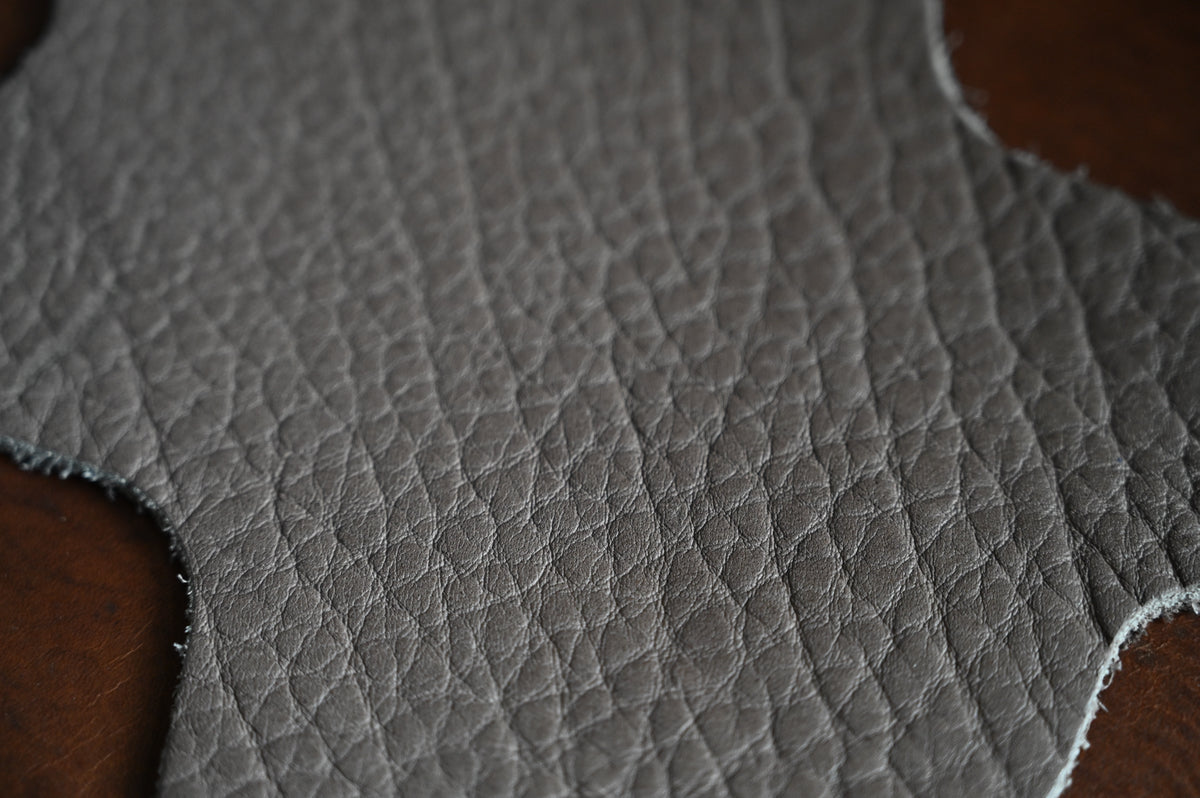
Leather Grains - Unique Features
Leather Grain refers to the texture and natural markings of a hide, revealing its quality, origin and treatment. Each type of grain offers distinctive features that cater to different needs and preferences.
Full-Grain Leather: Preserves the hide’s natural surface, including scars and wrinkles, making each piece unique. It’s highly durable and develops a rich patina over time, perfect for premium, long-lasting applications.
Corrected and Embossed Grains: Sanded to remove imperfections, these grains are often embossed with patterns, offering a polished, consistent texture. They balance durability and design flexibility.
Pebble Grain: Textured with a raised, small pebble-like surface that enhances grip and hides minor blemishes. Ideal for rugged yet stylish everyday items.
Smooth Grain: Sleek and uniform, this grain creates a modern, minimalist aesthetic, perfect for formal and professional products.
Exotic Grain: Features unique patterns like crocodile scales or ostrich quill bumps, offering bold, luxurious appeal. These are prized for their exclusivity and natural beauty.
Top-Grain Leather: A refined, practical option with a sanded surface and protective coating, offering a polished look and easy maintenance.
Split Grain: Made from the lower layers of the hide, it’s lightweight and budget-friendly but less durable. Often finished with synthetic coatings for a uniform appearance.
Whether for rugged durability, modern elegance, or exclusive luxury.
Each grain type blends texture, durability, and style to cater to various tastes and applications, ensuring every choice meets a unique need while celebrating the individuality of leather.
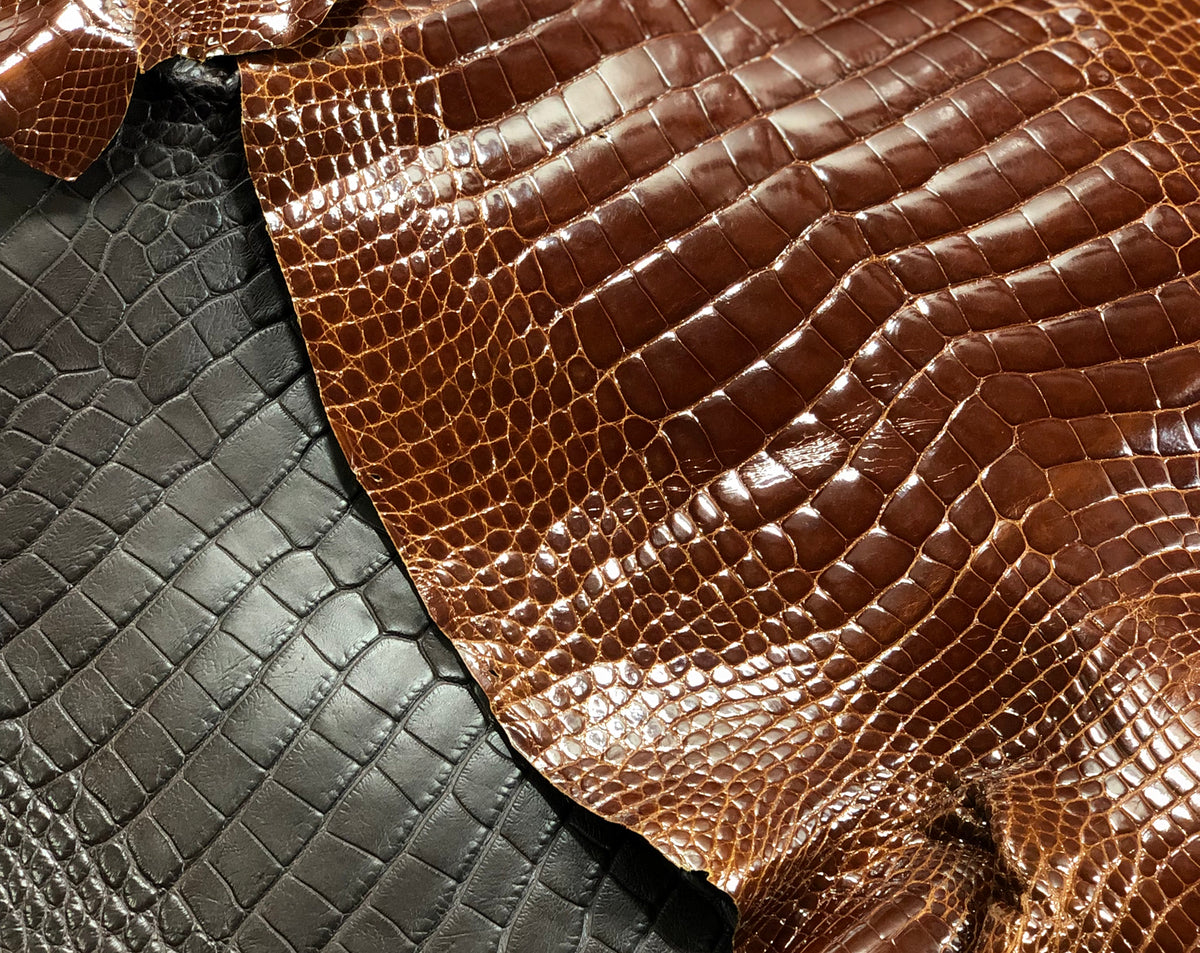
Leather Finishing
Leather finishing involves applying various treatments to enhance the durability, appearance, and texture of the leather. Common finishes include aniline, which leaves the surface natural and breathable, and semi-aniline, which adds a light protective coating while preserving a soft, natural look. Pigmented finishes offer more protection by coating the surface with a durable color layer, ideal for high-use items. For a luxurious touch, sueded finishes like nubuck and suede are created by buffing the surface or underside of the hide for a velvety feel. Embossing and printing can add decorative patterns or mimic exotic skins, while specialty finishes, such as metallic or pearlized, create bold, unique effects. Each finish can be tailored to different types of leather, from cowhide to exotic skins, ensuring versatility across a variety of uses.
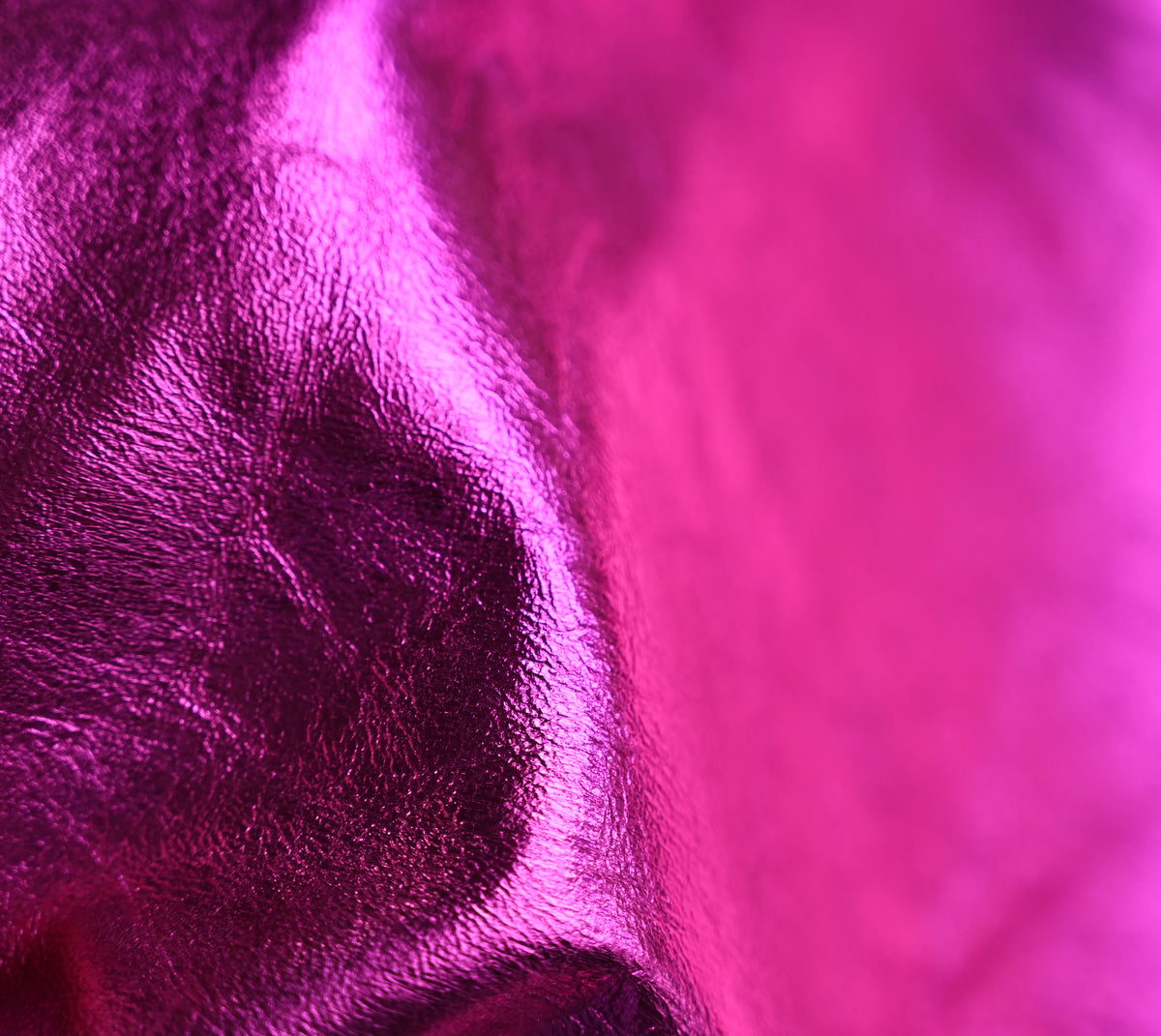
Metallic Finish
A metallic finish on leather imparts a striking luminescence that reflects light and accentuates the natural grain of various leather hides. By applying a special metallic foil or pigmented coating—whether on cowhide, lambskin, or exotic leathers—the surface takes on an eye-catching sheen, ranging from a subtle, shimmery glow to a bold, high-gloss shine. This finish not only adds a touch of glamour but also provides an extra layer of protection, ensuring that the underlying hide remains both durable and visually appealing.
What's the difference between?
Aniline and Semi-Aniline?
The Difference Between Aniline Leather and Semi-Aniline Leather
Aniline Leather
Aniline leather is dyed with soluble dyes that penetrate the leather without coating its surface, leaving the hide's natural grain and imperfections visible. This leather is not treated with any surface pigments or protective coatings, which gives it a soft, natural feel and a luxurious aesthetic. However, this lack of protection makes it highly absorbent, meaning it readily soaks up moisture, oils, and stains. Cleaning and caring for aniline leather require specialized products designed to gently cleanse without stripping its natural oils. Regular conditioning is crucial to maintain its suppleness and protect against drying.
Semi-Aniline Leather
Semi-aniline leather, like aniline, is dyed with soluble dyes to preserve its natural appearance. However, it features a light surface coating that includes pigments or protective finishes. This additional layer provides a degree of resistance against moisture, stains, and fading, making it more durable and easier to maintain compared to aniline leather. While it still retains some absorbency, it is less prone to staining, making it more suitable for high-traffic or everyday use. Cleaning and care are generally simpler, with less risk of damage during maintenance.
Key Differences in Absorbency and Care:
Absorbency - Aniline leather is more absorbent and sensitive to liquids and oils than semi-aniline leather, requiring prompt action to address spills. Semi-aniline leather’s have a light protective layer, reducing the vulnerability.
Cleaning and Care - Aniline leather requires gentle, specialized products and regular conditioning. Semi-aniline leather allows for a broader range of cleaning solutions and is more forgiving during maintenance.
Semi- Aniline and Pigmented?
The Difference Between Semi-Aniline Leather and Pigmented Leather
Semi-Aniline Leather
Semi-aniline leather is dyed with soluble dyes, preserving the natural grain and subtle imperfections of the hide. It features a light surface coating that provides some protection against moisture, stains, and fading while still maintaining a soft, natural feel. The coating enhances durability without entirely masking the leather’s texture, offering a balance between aesthetics and practicality. Semi-aniline leather has moderate absorbency, which makes it more resistant to staining compared to pure aniline leather, yet still requires appropriate care to prevent damage.
Pigmented Leather
Pigmented leather is treated with a substantial surface coating that includes pigments, giving it a uniform color and additional protection. This coating conceals most of the natural grain and imperfections of the hide, providing a more consistent appearance. Pigmented leather is highly durable, resistant to stains, fading, and moisture, making it ideal for high-use environments like automotive interiors, furniture, and public spaces. Its surface is far less absorbent than semi-aniline leather, which simplifies cleaning and maintenance.
Key Differences in Absorbency and Care
Absorbency - Semi-aniline leather has moderate absorbency due to its light coating, while pigmented leather is nearly non-absorbent because of its thicker protective layer.
Cleaning and Care - Semi-aniline leather requires gentler cleaning products to avoid damaging its natural finish, along with periodic conditioning to maintain softness. Pigmented leather, being highly resistant to moisture and stains, can be cleaned with a wider range of products and needs minimal conditioning.
Nubuck and Suede?
The Difference Between Nubuck and Suede
Nubuck Leather
Nubuck is made from the top grain of the hide, which is the outermost and most durable layer. The surface is sanded or buffed to create a soft, velvety texture, giving it a luxurious appearance. Because it is derived from the strongest part of the hide, nubuck is generally more durable than suede. However, its soft texture makes it more prone to staining and absorbing liquids, requiring careful maintenance. Cleaning nubuck involves using specialized brushes and sprays to preserve its nap and protect it from moisture and stains.
Suede Leather
Suede is made from the underside of the hide, known as the split or flesh side, resulting in a soft, pliable, and fuzzy texture. It has a more delicate structure compared to nubuck, making it less durable but equally sought-after for its elegant and casual aesthetic. Suede is highly absorbent and easily affected by moisture and stains, necessitating protective sprays and gentle cleaning tools to maintain its appearance. It is often used for items where flexibility and softness are key, such as shoes, bags, and garments.
Key Differences in Absorbency and Care
Absorbency - Both nubuck and suede are highly absorbent, but suede’s looser structure may make it slightly more prone to deep staining. Protective treatments are essential for both.
Cleaning and Care - Nubuck requires more attention to maintaining its nap and durability, while suede needs gentler handling to avoid damage to its delicate texture. Each benefits from waterproofing sprays and careful brushing.
Top Grain and Split Leather?
The Difference Between Top Grain Leather and Split Leather
Top Grain Leather
Top grain leather is made from the top layer of the hide, which is sanded and refinished to remove imperfections. While the surface is refined, it still showcases natural characteristics such as grain patterns and subtle marks, offering a balance of durability and authenticity. A finish is often applied to enhance its resistance to stains and wear, making it easier to clean and maintain. Simple care routines with leather cleaners and conditioners will keep top grain leather in excellent condition. Its strength and natural beauty make it a preferred choice for high-end furniture, bags, and automotive interiors.
Split Leather
Split leather is derived from the lower layers of the hide, separated from the top grain. It does not retain the natural grain and is typically embossed or coated to mimic the appearance of top grain leather. Split leather is most commonly used to produce genuine leather, a term often associated with entry-level or mass-market products. Due to its processing, split leather lacks the strength and suppleness of top grain leather. Cleaning requires careful handling to avoid damaging its artificial finish, and conditioners may not be as effective.
Key Differences in Identification, Cleaning, and Care
Identification - Top grain leather displays natural grain patterns and occasional nature marks, showcasing its authenticity. Split leather often features an embossed or uniform surface, a telltale sign of its processed nature.
Durability - Top grain leather retains the hide’s natural strength and is more durable than split leather, which is less robust.
Cleaning and Care - Top grain leather is easy to clean and condition, benefiting from mild leather care products. Split leather, with its artificial finish, requires gentler cleaning techniques to avoid wear.
Natural Grain and Embossed Grain?
The Difference Between Natural Grain and Embossed Grain Leathers
Natural Grain Leather
Natural grain leather refers to leather that retains the hide’s original, unaltered surface texture. The grain shows unique characteristics such as pores, wrinkles, and minor imperfections that reflect the hide’s natural beauty and authenticity. This type of leather is typically more supple and breathable since it has not undergone extensive surface treatments. It is highly durable, as it retains the hide’s full structural integrity. Cleaning natural grain leather requires gentle methods, such as mild leather cleaners and conditioners, to maintain its softness and protect its natural surface. Over time, it develops a rich patina, adding to its charm and character.
Embossed Grain Leather
Embossed grain leather undergoes a process where a machine or press applies a patterned texture to the surface, such as pebbled, crocodile, or other decorative designs. This process often smooths out imperfections, creating a uniform appearance. Embossed leather is typically made from corrected grain or split leather, and while durable, it may not be as strong as natural grain leather if it comes from the lower layers of the hide. The embossed texture provides a stylish and modern look but does not develop a patina in the same way as natural grain leather. Cleaning and care focus on maintaining the embossed pattern and often involve specialized products to ensure the design remains intact.
Key Differences in Identification, Durability, and Cleaning and Care
Identification - Natural grain leather showcases irregularities like pores, scars, or wrinkles, giving each piece a unique appearance. Embossed grain leather has a consistent and often intricate pattern, which can be easily recognized as machine-made.
Durability - Natural grain leather is more durable due to its unaltered structure, whereas embossed grain leather may vary in durability depending on the base leather used.
Cleaning and Care - Natural grain leather benefits from gentle cleaning and regular conditioning to preserve its natural look and develop a patina. Embossed grain leather requires cleaning products that do not harm the pattern or finish, and care must be taken to clean between the textured design.
Summary
Natural grain leather emphasizes authenticity and individuality, with unique characteristics and long-lasting durability that improves with age. Embossed grain leather offers a consistent, decorative appearance, often with modern or stylish patterns. Both require specific care routines, but natural grain leather's unprocessed nature makes it a timeless and robust choice, while embossed leather is ideal for those seeking a refined and uniform look.
Matte Finish and Glossy Finish?
The Difference Between Glossy Leather Finish and Matte Leather Finish
Glossy Leather Finish
Glossy leather is characterized by a shiny surface that reflects a significant amount of light, creating a polished and vibrant appearance. The high sheen is typically achieved through coatings, waxes, or lacquers applied during the finishing process. This reflective quality enhances the leather’s visual appeal, making it look sleek and luxurious. Glossy leather is often used in high-fashion accessories, footwear, and automotive interiors for its bold and striking presence. However, the reflective surface can make scratches and imperfections more visible over time. Cleaning glossy leather requires non-abrasive products that maintain its luster without dulling the finish.
Matte Leather Finish
Matte leather has a flat, non-reflective surface that absorbs light rather than reflecting it, giving it a subtle and understated appearance. This finish emphasizes the leather's natural texture and is often associated with a more casual or organic look. Matte leather is less likely to show fingerprints or minor blemishes, making it a practical choice for everyday use. Cleaning and care for matte leather require gentle products that preserve its natural finish without adding shine or altering its understated look.
Key Differences in Light Reflection and Care
Light Reflection - Glossy leather reflects light, creating a shiny, eye-catching surface, while matte leather absorbs light, resulting in a soft, muted appearance.
Aesthetic Appeal - Glossy finishes convey sophistication and luxury, while matte finishes offer a natural, understated elegance.
Maintenance - Glossy leather requires careful cleaning to prevent streaks and maintain its shine, while matte leather is more forgiving and easier to maintain, with less risk of visible smudges or wear.
Summary
The choice between a glossy and matte leather finish often comes down to personal preference and intended use. Glossy leather provides a bold, high-end look with its reflective sheen, while matte leather offers a more subdued and natural aesthetic. Understanding these differences ensures proper care to maintain each finish’s unique characteristics.
Top Coated and Non-Top Coated?
The Difference Between Top-Coated Leather and Non-Top-Coated Leather
Top-Coated Leather
Top-coated leather, often referred to as "protected leather," has a clear or pigmented coating applied to its surface during the finishing process. This topcoat serves as a barrier, protecting the leather from wear, stains, and fading. It gives the leather a more uniform appearance and can have a glossy, semi-gloss, or matte finish. The coating reduces the leather’s absorbency, making it more resistant to moisture and easier to clean. Regular cleaning and occasional conditioning are essential to maintain the protective layer and prevent cracking or peeling over time.
Non-Top-Coated Leather
Non-top-coated leather, sometimes called "unfinished" or "natural" leather, lacks a protective surface coating, leaving the hide’s natural texture and grain exposed. Examples include aniline and nubuck leather. This type of leather is highly absorbent, making it more susceptible to staining, fading, and moisture damage. Non-top-coated leather requires careful cleaning and regular conditioning to replenish its natural oils and maintain its suppleness. Protective sprays may be used to reduce susceptibility to stains, but care must be taken not to alter its natural appearance.
Key Differences in Durability, Absorbency, Cleaning, and Care
Durability - Top-coated leather is more durable due to its protective layer, making it suitable for high-use environments like furniture or automotive interiors. Non-top-coated leather is less resistant to wear and requires more careful handling.
Absorbency - Top-coated leather is less absorbent, while non-top-coated leather readily absorbs liquids, making it prone to staining.
Cleaning - Top-coated leather can be cleaned with mild leather cleaners and a soft cloth or select cleaning brush, as its surface resists penetration. Non-top-coated leather requires gentle cleaning methods to avoid damaging its natural surface.
Care Practices - Top-coated leather benefits from occasional conditioning to prevent the topcoat from drying or cracking. Non-top-coated leather requires more frequent conditioning to maintain its softness and appearance, as well as protective treatments to guard against stains and moisture.
Summary
Top-coated leather offers greater durability and ease of maintenance due to its protective layer, while non-top-coated leather emphasizes natural beauty but demands more diligent care. Choosing between the two depends on the intended use, the desired aesthetic, and the commitment to maintenance routines.
Real Leather and Vegan Leather?
The Difference Between Real Leather and Vegan Leather
Real Leather
Real leather is made from animal hides, primarily from cows, goats, or other livestock. It undergoes tanning processes, such as chrome tanning or vegetable tanning, to preserve and stabilize the material. Real leather is valued for its durability, natural texture, and ability to develop a patina over time, which enhances its character. It is breathable, long-lasting, and repairable when properly maintained. Real leather requires routine cleaning and conditioning to prevent dryness and maintain its flexibility.
Vegan Leather
Vegan leather, also known as synthetic or faux leather, is made from non-animal materials, most commonly plastics like polyurethane (PU) or polyvinyl chloride (PVC). It is designed to mimic the appearance and feel of real leather while being entirely animal-free. Vegan leather offers a uniform texture and appearance, with various finishes available to suit different design needs. While it is often more affordable, vegan leather is less breathable and may not age as gracefully as real leather. Cleaning is typically simpler, as it resists stains and moisture better than real leather. However, it is less repairable and may degrade or peel over time, especially under harsh conditions.
Key Differences
Material - Real leather is derived from animal hides, while vegan leather is made from synthetic materials, primarily plastics.
Durability - Real leather is more durable and ages well, developing a patina, whereas vegan leather tends to degrade or peel over time.
Appearance and Texture - Real leather features natural grain and imperfections, while vegan leather offers a consistent and uniform look.
Breathability - Real leather is breathable and adapts to temperature changes, while vegan leather lacks breathability due to its synthetic composition.
Care - Real leather requires conditioning to maintain flexibility and prevent cracking, while vegan leather is easier to clean but cannot be repaired or rejuvenated as effectively.
Summary
Real leather is a durable, natural material prized for its longevity, unique texture, and ability to age gracefully, requiring consistent care for long-term use. Vegan leather offers an animal-free alternative with a uniform look and low-maintenance care but lacks the breathability and longevity of real leather. The choice depends on personal values, budget, and intended use.
Leather Types
-

Aniline
Aniline leather is known for showcasing the natural top grain and unique markings of the hide. It can have a natural, untreated appearance, often associated with vegetable tanning, or be fully dyed throughout using soluble dyes. To identify aniline leather, try a simple water test. If a drop of water soaks in quickly, leaving a water spot or small stain, it’s likely aniline leather.
-

Semi-Aniline
Semi-aniline leather combines the natural beauty of aniline leather with added durability. It’s dyed with soluble dyes to showcase the hide’s natural grain but also has a light surface coating or pigment. This finish enhances stain resistance and color consistency while still retaining a soft, natural look. Semi-aniline leather is ideal for those who want the elegance of natural leather with extra protection for everyday use.
-

Pigmented
Pigmented leather is valued for its durability and consistent appearance, making it ideal for daily use. It features a solid layer of pigment and a protective coating that conceals most natural markings. This finish improves resistance to stains, fading, and wear, while offering a wide variety of color options, making it both practical and easy to maintain.
-

Nubuck
Nubuck leather is a top-grain leather known for its soft, velvety surface. It’s created by lightly sanding the outer layer of the hide, enhancing its texture while maintaining durability. Like aniline leather, Nubuck absorbs water quickly due to its porous surface, making it more prone to staining. Proper care is essential to preserve its natural, luxurious look.
-

Suede
Suede leather is a type of leather characterized by its soft, velvety surface, created by buffing the split side of the hide. Lightweight and flexible, suede is prized for its luxurious texture and versatility in fashion and accessories, such as shoes, jackets, and bags. While aesthetically appealing, suede is more delicate than full-grain leather and requires proper care to protect it from moisture and stains.
-

Pull Up
Pull-Up Leather is full-grain leather treated with oils or waxes, giving it a supple feel and a rich, vintage look. When stretched or bent, it reveals lighter color variations, adding to its character and patina over time. Known for durability and rugged charm, it’s ideal for boots, bags, and furniture, requiring occasional conditioning to maintain its finish.
-

Genuine Leather
Genuine leather refers to leather that has been processed and finished to meet basic standards of quality and durability. The term "genuine" signifies that the material is made from real animal hide, distinguishing it from synthetic alternatives like faux leather.
This leather is typically derived from the lower layers of a hide after the top-grain is removed. It undergoes treatments such as embossing or dyeing to enhance its appearance, often imitating the look of higher-quality leather. While less durable and supple than full-grain or top-grain leather, genuine leather is valued for being more affordable while still offering the authenticity of real hide. Proper care can extend its lifespan and maintain its finish.
-

Perforated
Perforated leather features a series of small, uniform holes punched into the surface, enhancing its breathability and aesthetic appeal. This design allows for improved airflow, making it ideal for applications where comfort and temperature regulation are important.
The perforation process can be applied to various types of leather, including full-grain and top-grain, without compromising durability or softness. Perforated leather requires the same care as non-perforated leather, with attention to gentle cleaning to prevent debris from accumulating in the perforations. Its combination of functionality and style makes it a versatile choice for both practical and decorative uses.
-

Nappa
The term "Nappa leather" is believed to have originated in the late 19th century in Napa, California, where the tanning process first gained recognition for producing exceptionally soft, pliable hides. Today, it is widely used because of its fine, uniform grain and luxurious feel, making it a popular choice for high-end products that prioritize comfort and durability.
-

Embossed
Embossed leather is created by pressing a design or texture onto the hide using heat and pressure. This process can mimic exotic patterns or produce custom styles, providing a uniform, decorative finish while preserving the leather’s durability. Vegetable-tanned leather is most commonly used for this process because it is pliable and receptive to detailing. It can also be tooled by hand for a more personalized, artisanal touch.
-

Antiquing
Antiquing is a finishing process designed to give leather a vintage or aged appearance by accentuating its natural grain, creases, and markings. This is typically achieved using specialized dyes, waxes, or stains, which darken recessed areas more than raised surfaces. The result is a weathered look that enhances the leather’s depth and character while maintaining its durability.
-

Olive Tanned
Olive tanned leather is a sustainable and eco-conscious material, crafted using tannins derived from olive leaves, a byproduct of olive harvesting. This innovative tanning method not only minimizes environmental impact but also imparts a distinctive and natural greenish hue to the leather. Renowned for its softness, durability, and eco-friendly appeal, olive tanned leather offers a unique aesthetic while supporting sustainable practices in leather production.
-

Shell Cordovan
Shell Cordovan leather is a premium, highly sought-after material renowned for its smooth, glossy finish, remarkable durability, and resistance to creasing. This unique leather is sourced from the hindquarters of a horse, specifically the dense, fibrous membrane beneath the skin, known as the "shell." The meticulous tanning process can take several months, resulting in a luxurious leather prized for its longevity and distinctive appearance.
-

Crazy Horse
Crazy Horse leather is a full-grain leather known for its exceptional durability and distinctively aged appearance. It is treated with a special wax that enhances its natural characteristics, allowing the surface to develop a rich patina over time. This leather is prized for its ability to showcase unique scratches, marks, and variations, giving it a vintage and rugged charm. Despite its name, Crazy Horse leather is not derived from horses but typically from high-quality cowhide, crafted to highlight its natural beauty.
-

Hair on Hide
Hair-on-hide leather is a type of leather where the animal's fur or hair is preserved during the tanning process. This method retains the natural texture, patterns, and coloration of the hide, showcasing the unique characteristics of the animal's coat. It is both durable and visually distinctive, offering an authentic representation of the original material.
-

Bison
Bison leather is renowned for its remarkable strength, durability, and distinctive grain pattern that sets it apart from other types of leather. Its natural texture showcases unique character, often featuring visible variations and markings that highlight its authenticity.
-

Alligator / Crocodile
Alligator and crocodile leather are prized exotic materials known for their luxurious texture and distinctive scale patterns. Durable yet supple, they are often used in high-end products like handbags, wallets, and footwear. Their natural elegance and unique patterns make each piece unique, requiring careful conditioning to maintain their beauty and longevity.
Farm-raised hides typically offer more uniform scales and softer textures, while wild-sourced hides feature more varied patterns and natural markings, reflecting the animal’s life in the wild.
-

Python
Python leather is an exotic material prized for its distinctive scale patterns and striking aesthetic. Commonly sourced from selective python species, it’s used in high-end fashion for items like footwear, handbags, and accessories that emphasize luxury and uniqueness. Due to its delicate scales, python leather requires specialized care, including gentle cleaning to remove dirt and occasional conditioning with products formulated for exotic skins. It’s also crucial to store python leather away from direct sunlight and excessive humidity to maintain its vibrant appearance and structural integrity.
-

Ostrich
Ostrich leather is a premium exotic material celebrated for its softness, durability, and unique quill pattern. The distinctive raised bumps, created by feather follicles, give it a luxurious and recognizable texture.
Highly flexible and resistant to wear, ostrich leather is both practical and elegant. Its natural oils enhance its durability, preventing cracking and maintaining a supple feel over time. Proper care involves regular conditioning and cleaning to preserve its unique texture and rich appearance.
-

Stingray
Stingray leather is an exotic material renowned for its distinctive pebble-like texture and exceptional durability. Its surface features a natural bead-like pattern, often accented by a prominent "pearl" marking from the spine, giving it a unique and luxurious appearance.
Highly resistant to water, fire, and abrasion, stingray leather combines strength with elegance. Proper care involves gentle cleaning and avoiding excessive bending to maintain its texture and structural integrity.
-

Elephant
Elephant leather is a rare and durable material known for its unique texture and distinctive grain pattern. Ethically sourced from legal channels, it offers exceptional strength and a luxurious feel, making it a prized choice for exclusive leather goods.
-

Rhino
Rhino leather is an exceptionally rare and durable material, valued for its distinct texture and natural resilience. Sourced through ethical and controlled means, it embodies a unique aesthetic and is highly regarded for its strength and exclusivity.
-

Fish Leather
Fish Leather is a unique and sustainable material made from the skins of fish such as salmon, perch, or cod. Despite its unconventional source, it is highly durable, with a tensile strength that often surpasses traditional bovine leather of similar thickness. Fish leather retains the natural scale patterns of the species, creating a distinct and visually striking texture. Its lightweight and flexible nature make it suitable for a variety of applications.
-

Fish Leather
Fish leather is crafted from the by-products of the fishing and seafood industries, utilizing skins from species such as salmon, perch, cod, tilapia, and catfish. These skins, sourced from both wild-caught and farmed fish, are sustainably processed by tanneries, including those in Iceland, which rely on fishing fleets from Iceland, Norway, and the Faroe Islands. By repurposing these materials, fish leather production reduces waste and exemplifies environmentally conscious practices.
-

Bird Feet Leather
Bird feet leather is an exceptionally rare and exotic material crafted from the skin of bird feet, often from larger birds such as ostriches or emus. Known for its unique texture, it features intricate patterns formed by the natural scaly structure of the bird’s skin. Despite its unconventional source, bird feet leather is surprisingly durable and flexible, making it suitable for small accessories or decorative applications.
-

Pigskin Leather
Pigskin leather is a durable material known for its characteristic grain pattern with small, visible pores. Valued for its strength, flexibility, and breathability, it is commonly used in footwear, gloves, and upholstery. Typically chrome-tanned, it offers enhanced durability and various finishes. As a byproduct of the meat industry, pigskin leather is an economical and resource-efficient option.
-

Vinyl
Vinyl is a synthetic material made from polyvinyl chloride (PVC), widely used for its durability, water resistance, and affordability. Often crafted to mimic the appearance of leather, vinyl can replicate the texture and grain patterns of genuine hides. While it lacks the natural qualities and patina development of real leather, vinyl offers a practical, low-maintenance alternative for a variety of applications.
-

Embossed Vinyl
Embossed vinyl is a synthetic material designed to replicate the texture and appearance of natural materials, such as leather, wood, or fabric, by imprinting patterns or designs onto its surface. This is achieved through a heat and pressure process, where an embossing plate or roller creates the desired texture, adding depth and visual appeal.
-

Bonded
Bonded leather is a composite material made by combining shredded leather fibers with a polyurethane or latex backing, bonded together with adhesives. While it contains genuine leather content, its surface is often embossed to mimic the appearance of full-grain or top-grain leather. Known for its affordability and uniform texture, bonded leather offers a cost-effective alternative, though it lacks the durability and aging qualities of higher-grade leathers.
-

Vegan Leather
Vegan leather is a synthetic alternative to traditional leather, crafted without the use of animal products. Typically made from materials like polyurethane (PU)or similar polymers, it is designed to replicate the appearance, texture, and durability of genuine leather. While not biodegradable due to its petroleum-based origins, its production often uses fewer resources, such as water and chemicals, compared to traditional leather tanning processes.


Pigmentation vs. Dyeing: How Leather Gets Its Color
Not all leather is colored the same way. In fact, the way color is applied affects more than just appearance — it influences feel, aging, repairability, and patina development.
Dyeing – Penetrative Color
Dyeing infuses the leather with color by soaking or drum-tumbling the hides in dye solutions. This method allows the color to absorb deep into the fibers, often resulting in a rich, transparent look that enhances natural grain character.
Different tanneries employ unique dyeing methods to achieve their signature looks. Some use traditional drum-dyeing with heat and repeated immersion, while others may apply color by hand for artisan finishes. For instance, small Italian workshops often hand-dye vegetable-tanned hides to emphasize tonal variation, while larger commercial tanneries may use automated flow systems to ensure uniformity. Historically, natural dyes derived from plants, roots, and minerals were used long before modern synthetics — a method still respected today among heritage leather producers.
- Common in: aniline and semi-aniline leathers
- Touch: soft, supple, natural
- Appearance: color variation, visible pores
- Repair: difficult to color-match precisely
- Patina: develops richly over time
Pigmentation, Surface Color
Pigmentation adds a color layer to the surface using pigments suspended in binders (typically polyurethane or acrylic). These finishes sit atop the grain and can completely mask the leather's natural appearance, making color uniform and highly protective.
This process is engineered more for durability than for showcasing the leather’s natural beauty. Many tanneries apply pigment in multiple passes, often layering sealers, fillers, and embossed textures to standardize the look across large batches. In the automotive industry especially, surface pigmentation ensures resistance to UV light, abrasion, and chemical exposure — all critical for long-term vehicle use.
In luxury goods, some brands use refined pigment applications that still allow slight natural grain peeking through. Others employ digital printing, embossing, or top-coating with semi-matte polyurethane to achieve aesthetic effects while maximizing protection.
- Common in: corrected grain, automotive OEM leather, upholstery hides
- Touch: smooth or matte, less “buttery”
- Appearance: even color, grain may be embossed or obscured
- Repair: easier to color-match and refinish
- Patina: minimal — wear shows as damage, not charm
- Example: most modern car interiors, fashion bags with uniform texture
The Role of pH: Balance, Breakdown, and Longevity
Leather is a living material — even after tanning, its structure remains sensitive to environmental changes. One of the most important (and often overlooked) factors in leather aging is pH.
What Is pH in Leather?
pH measures acidity or alkalinity on a scale from 0 (acidic) to 14 (alkaline), with 7 being neutral. Leather is at its healthiest when it maintains a slightly acidic balance, typically around pH 4.5 to 5.5.
⚠️ Why It Matters
If the pH drifts outside of its comfort zone — especially toward alkaline — leather fibers can weaken, dry out, or even chemically degrade.
Everyday Influences on pH
- Soaps & cleaners: Many are alkaline and slowly strip protective finishes
- Body oils: Human skin is naturally acidic and can shift surface pH over time
- Moisture: Water pH (especially from hard water) affects leather chemistry
- Sunlight & heat: Can accelerate chemical changes in pH-sensitive finishes
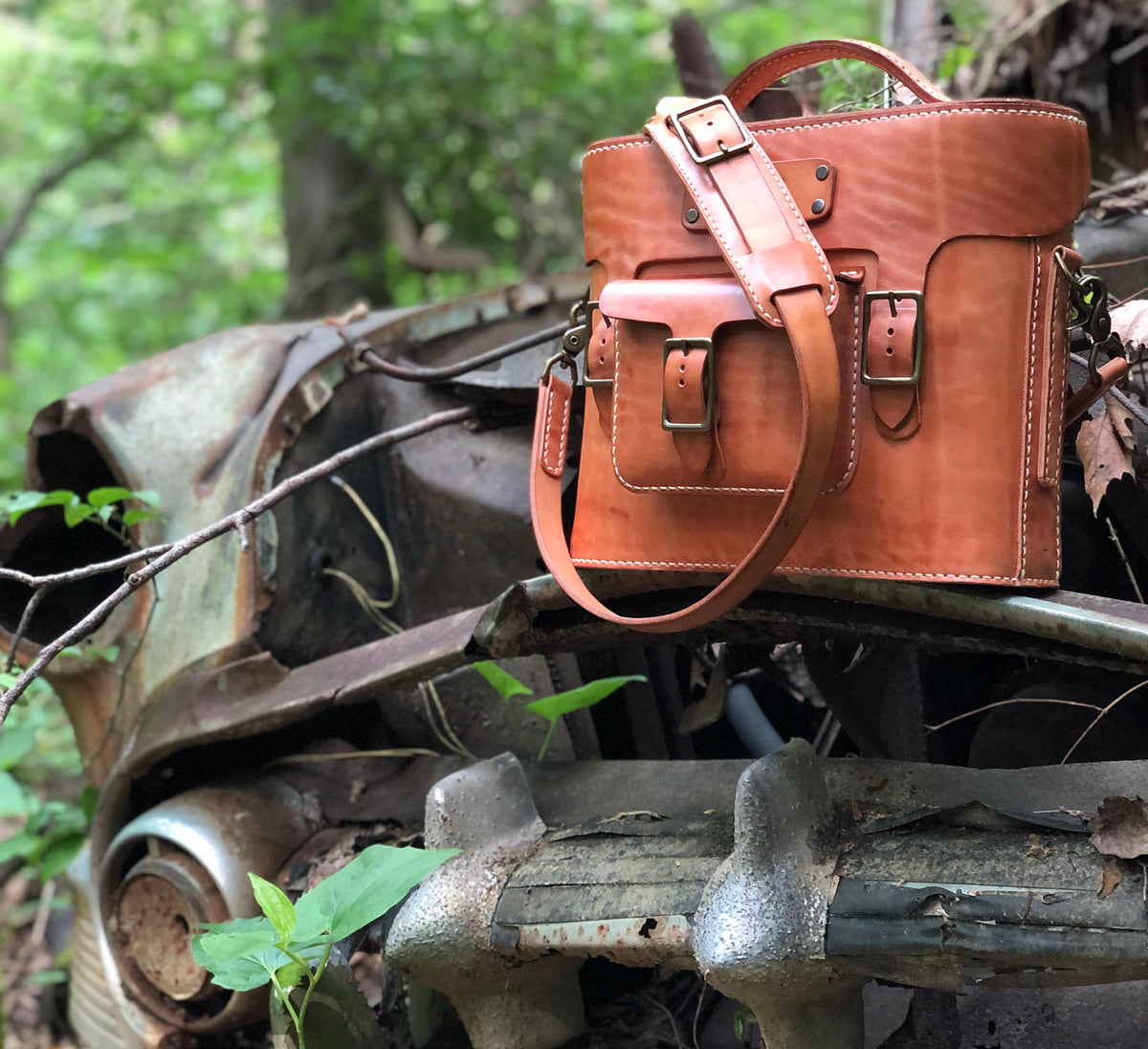
What is Patina on Leather?
Patina refers to the natural changes in the appearance and feel of leather as it ages. Unlike synthetic materials, which degrade over time, leather’s aging enhances its character. The process results in deepened colors, subtle sheens, and unique markings that reflect the life of the item. It is a mark of authenticity and a testament to the material’s quality.

Worldwide Leather
Production
The global leather industry produces millions of square meters of leather each year. As of recent estimates, approximately4 billion square feet (or over 370 million square meters) of leather are produced annually worldwide. This leather is sourced primarily from the meat industry, with cattle hides being the most common raw material. The production varies by region, with significant contributions from countries like China, India, Brazil, and Italy. The demand for leather is driven by sectors such as fashion, automotive, furniture, and footwear, with an ongoing shift toward more sustainable and eco-friendly practices within the industry.
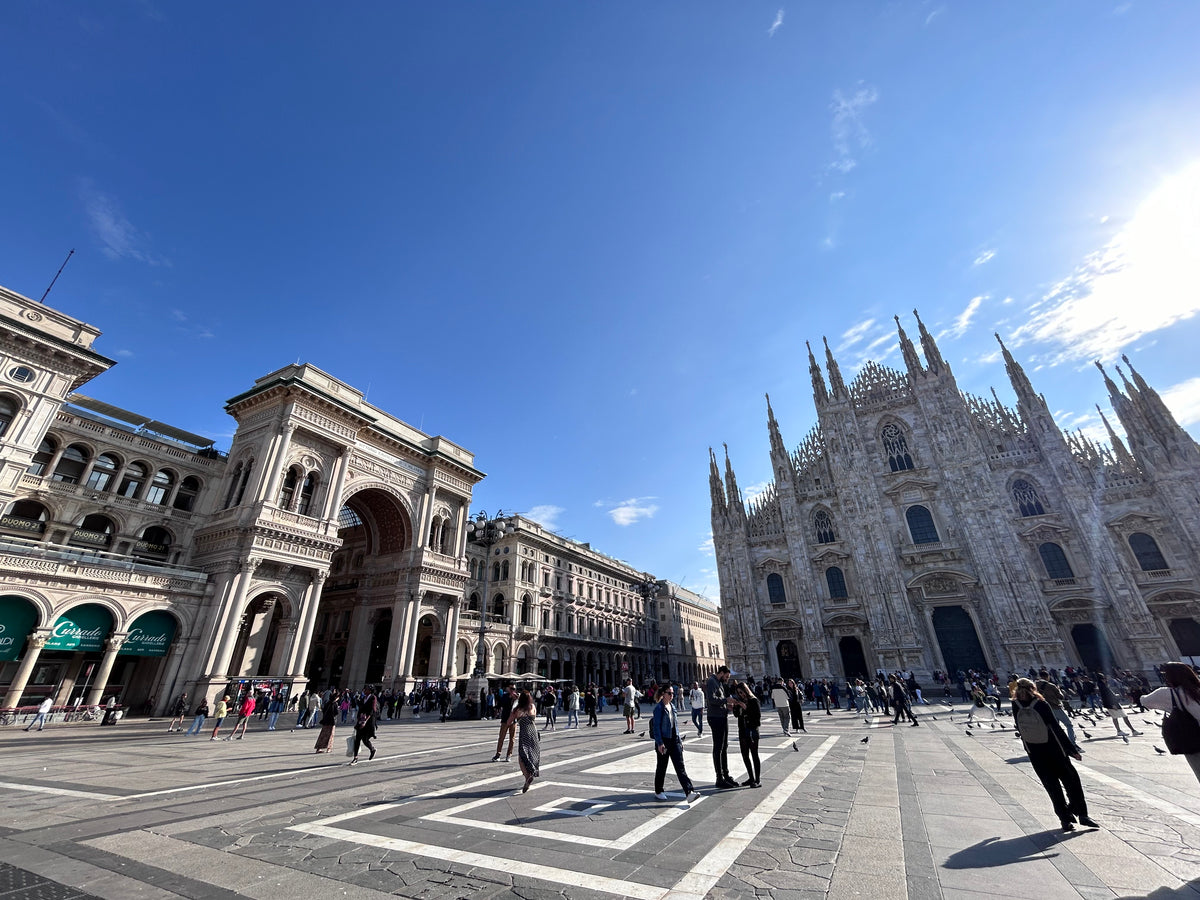
Tried and Proven
Uses Of Leather
Leather is a versatile material used globally across diverse industries due to its durability, flexibility, and timeless appeal. Tried and proven over centuries, it is prominently featured in fashion, including footwear, clothing, accessories, and is integral to automotive & furniture upholstery for its luxury feel and resilience. Leather is also essential in industrial applications, such as protective gear and machinery components, as well as in artisanal goods like saddlery, bookbinding, and bespoke crafts. Its adaptability ensures continued relevance in both functional and decorative applications worldwide.
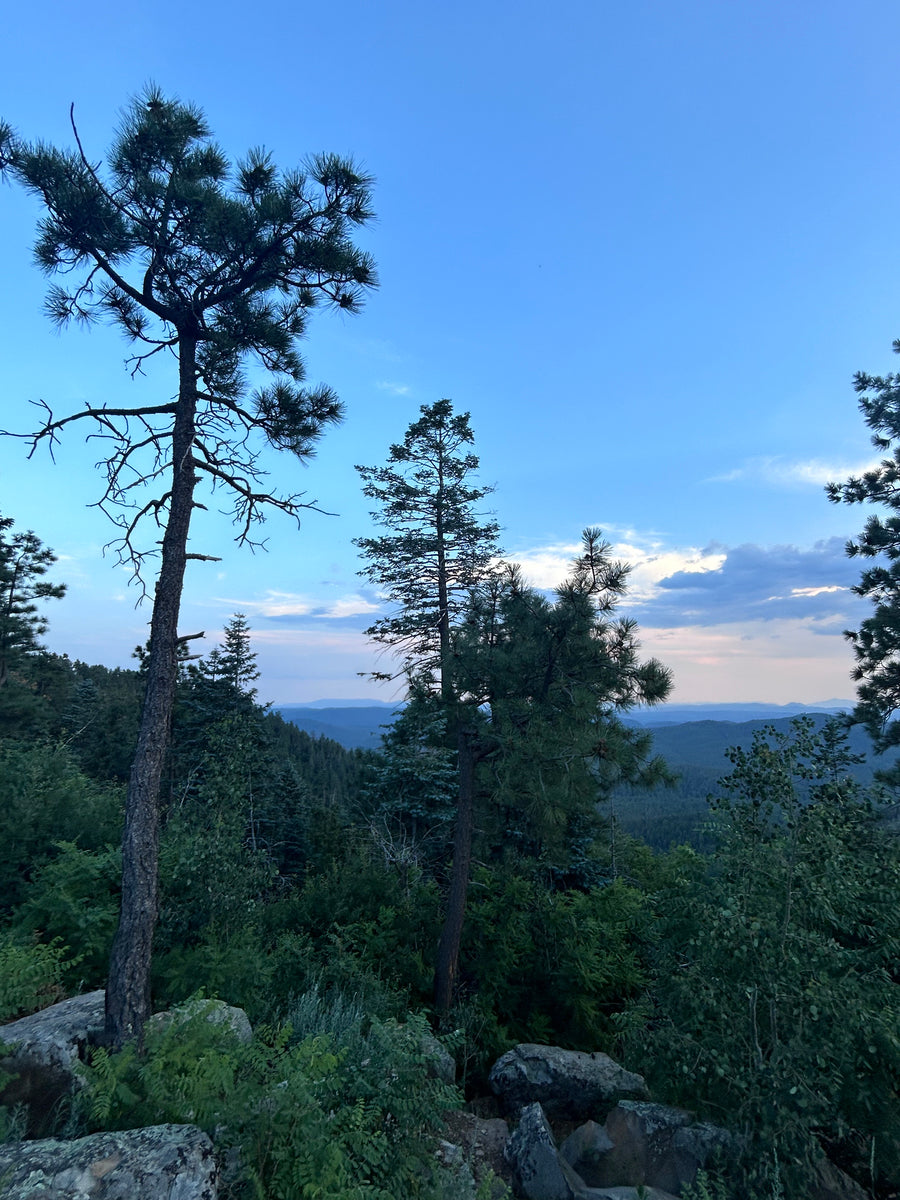
Eco-Conscious Practice
Sustainable
The leather industry is advancing sustainability by blending traditional craftsmanship with modern, eco-conscious practices. Many tanneries are committed to safer production methods, incorporating natural processes like vegetable and olive tanning, which use plant-based tannins to reduce chemical waste and produce biodegradable leather. By implementing resource-efficient systems, responsibly sourcing hides as byproducts of the meat industry, and adopting chrome-free technologies, these tanneries honor the heritage of leather production while prioritizing environmental and human well-being. This approach ensures the creation of high-quality leather that meets the demands of a greener, more sustainable future.
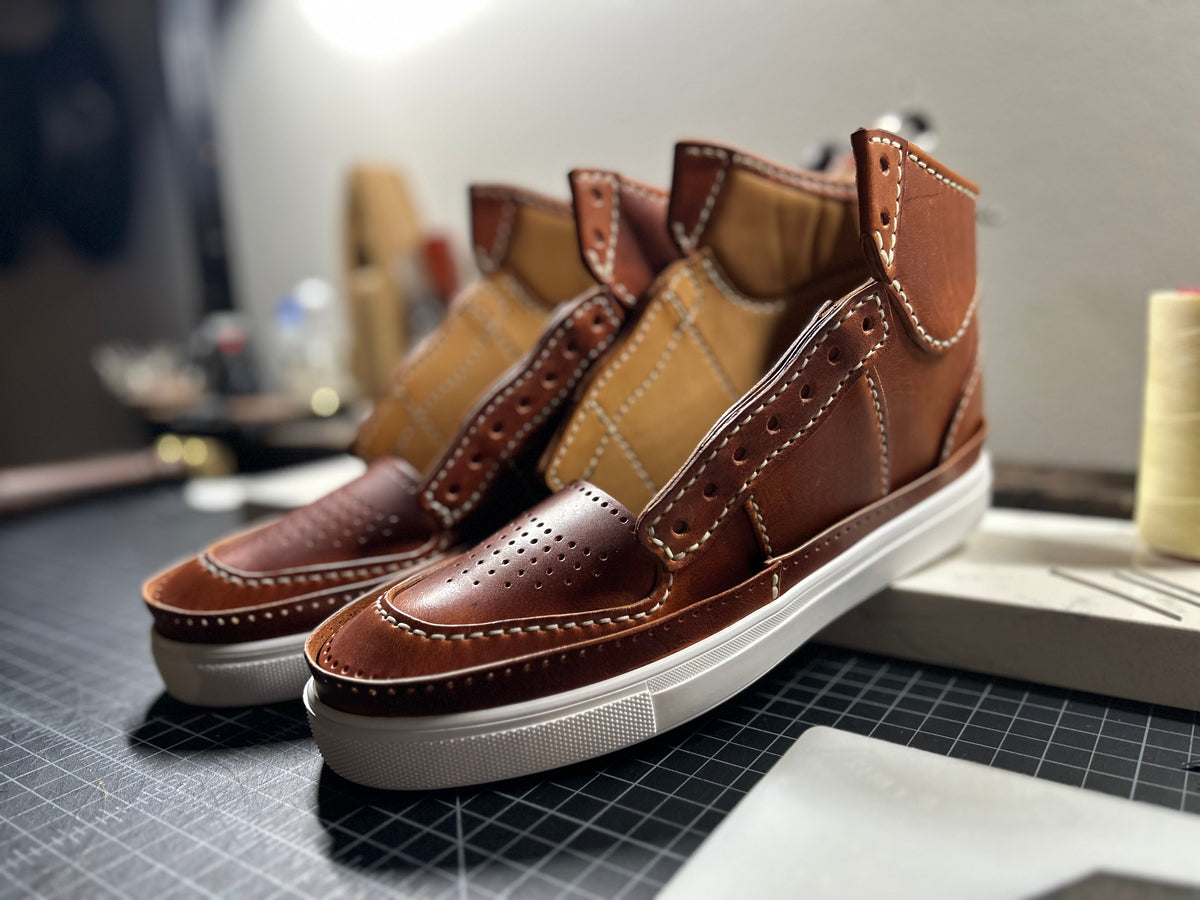
New leather gains character over time
often showing signs of wear.
Common Leather Damages?
-

Cracking and Drying Out
Caused by a lack of conditioning and prolonged exposure to heat, UV rays, or dry environments. Leather loses its natural oils, leading to brittleness and cracks.
-

Fading and Discoloration
Prolonged exposure to sunlight or artificial light can fade leather color. Stains and improper cleaning can also alter its appearance.
-
Scratches and Scuffs
Results from sharp objects or regular wear and tear. Some leathers are more susceptible to surface marks, especially aniline or nubuck.
-

Abrasion Damage
Seen in high-use areas where constant friction wears down the leather surface, often leaving it thin or rough.
-
Tears and Punctures
Caused by sharp objects or excessive force. It’s more common in thinner leather types or older, brittle leather.
-
Stains and Spills
Liquids like water, oil, ink, or wine can penetrate leather, leaving stains that are difficult to remove if untreated.
-

Peeling and Flaking
Common in bonded or faux leather but can also occur in low-quality finished leather. It happens when the protective top layer deteriorates.
-
Stretching and Sagging
Happens with overuse or when leather is improperly maintained, especially in furniture and automotive seats.
-
Swelling
Occurs when leather absorbs excessive moisture or water, causing it to expand unevenly. This can lead to structural damage or distortion if not addressed promptly.
-
Mold and Mildew
Develops in humid or damp conditions where leather isn’t stored or ventilated properly.
-
Burns and Heat Damage
High heat from direct contact with hot objects or extreme sunlight can burn or warp leather surfaces.
-
Edge Wear and Fraying
Common in leather accessories like bags, wallets, and belts. Edges can become rough or fray over time without proper finishing.
-
Stiffening or Hardening
Happens when leather is overexposed to water and left to dry improperly, losing its natural flexibility.
-
Ink and Pen Marks
Commonly seen on handbags, furniture, or car interiors, these marks are often accidental and challenging to remove.
-
Grease and Oil Build-Up
Especially in high-contact areas like headrests, armrests, or collars where body oils accumulate over time.
-
Delamination
Occurs when bonded or synthetic leather starts to separate or peel away from its backing material.
-
Stitching Damage
Over time, threads securing leather can weaken or break, leaving items structurally compromised.
-
Oxidation or Rust Staining
A type of leather damage caused by prolonged exposure to moisture, leading to rust from metal hardware like zippers or rivets staining the leather surface.

How To Care For Your Leather Goods
With proper care your leather will last a very long time!
General Care Guidelines
Regular Cleaning: Use a soft, lint-free cloth to gently wipe the leather surface weekly, removing dirt and dust to keep it looking its best.
Choose the Right Cleaners: Avoid household cleaning products that can harm the leather. Instead, opt for pH-balanced cleaners specifically designed for leather care.
Condition Consistently: Replenish the leather’s natural oils and maintain its softness by applying a high-quality leather conditioner every 3 to 6 months.
Perform a Patch Test: Before using any new product, test it on a small, inconspicuous area to ensure it won’t cause discoloration or damage.
Consult a Professional: For delicate, unique, or heavily damaged leather items, seek expert advice to ensure proper care and avoid potential harm.
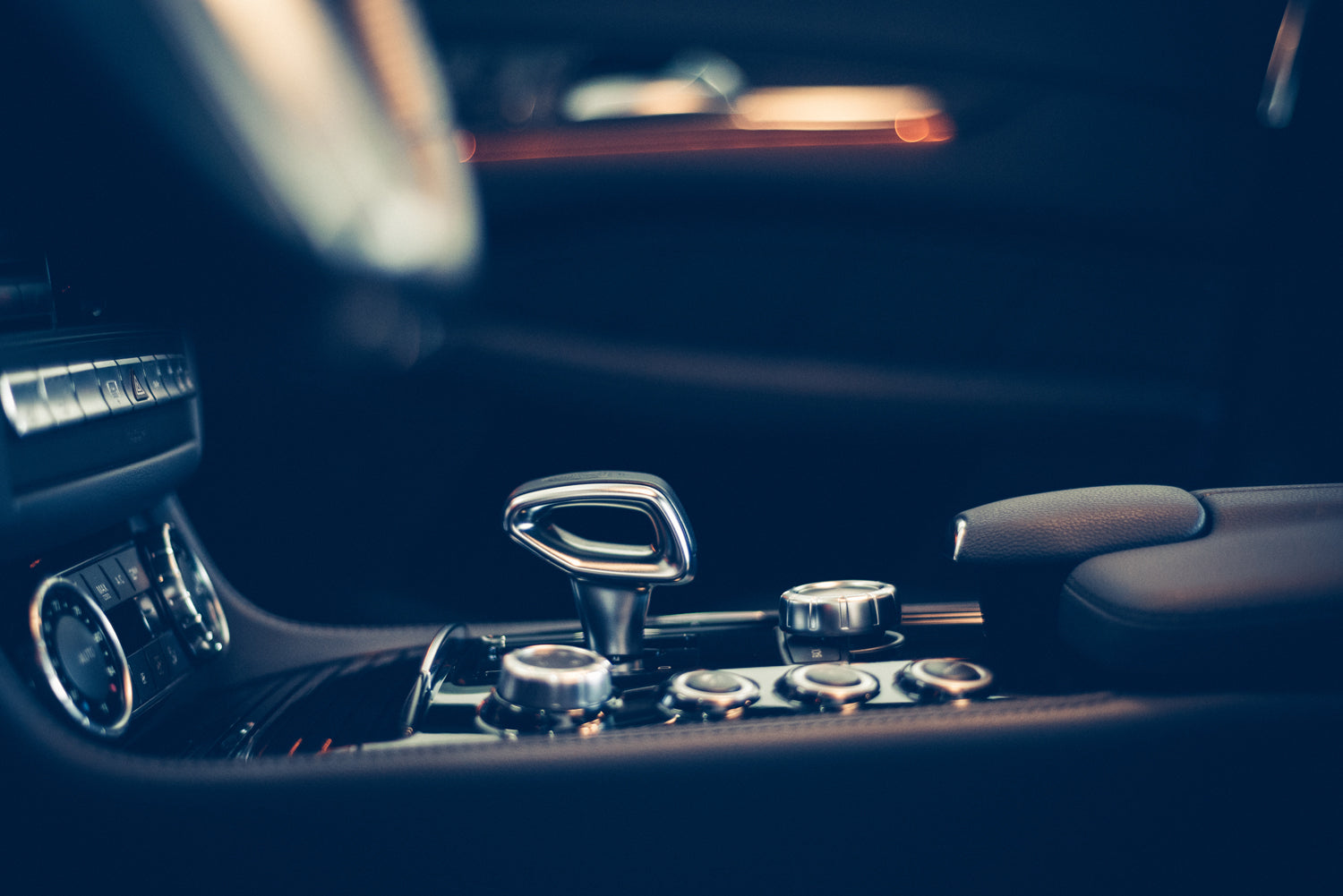
The Leather ID Guide for Automotive Enthusiasts
Explore Leather Types, Common Damages, and Expert Solutions
